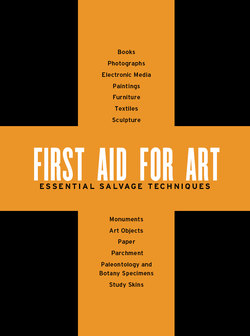Читать книгу First Aid for Art - Jane K. Hutchins - Страница 5
ОглавлениеElectronic Media
Properties
• Electronic media include CDs, DVDs, reel-to-reel tape, videotape, cassette tape, microfilm, and computer diskettes.
• The information stored on the media is more important than the carrier or housing.
• CDs and DVDs are fairly stable under most conditions, even when wet.
• Color media are more sensitive than black-and-white.
• Wet electronic media are best handled by experts.
Common Types of Damage
• Wet materials may grow mold.
• Edges are vulnerable to damage.
• Dust and debris can scratch and degrade media.
• Exterior debris indicates interior debris; treat as damaged.
• Exterior moisture indicates interior moisture; treat as water damaged.
• In wet conditions, labels may come loose and/or adhere to the wrong spot or item.
• Inks may run when wet.
• Extreme heat can melt media; extreme cold can make them brittle.
Supplies
What You May Need and Why
• Camera
• Pencils and paper for keeping records
• Protective gloves (nitrile, vinyl, or neoprene) for handling media
• Safety gear, including a respirator, if mold or contamination is present
If Media Are Wet
• Rubber bands, to keep identifying information and packaging with damaged items
• Distilled water, for rinsing off grit
• Blotter paper or lint-free cloth
• A vacuum cleaner with HEPA filter, if mold is present
• Fans and dehumidifiers
• Plastic bags for packing
If Media Are Dry
• Protective gloves (nitrile, vinyl, or neoprene), to avoid contaminating items
• Soft brushes for removing grit
• A vacuum cleaner with HEPA filter, if mold is present
• Lint-free cloth for cleaning
• Bubble wrap for cushioning
• Plastic bags for transporting
Triage
How to Decide What to Treat First
• Treat wet items first, before they dry.
• Treat color before black-and-white; color is more susceptible to damage.
• Treat old tapes before new tapes. Treat very old tapes with paper substrates first.
• Treat tapes and film before CDs and DVDs.
• A shattered CD can’t be repaired; a slightly warped one may be playable.
• A melted tape can’t be repaired.
What to Do
• Keep records—of conditions at the time of the emergency, and of your actions and when you take them. Use both words (a diary or log) and photographs. This information may be vital in discussions with an insurance company or lender, or to document when damage occurred (e.g., in the disaster vs. during handling).
• Keep identifiers (labels, box or shelf numbers, etc.) with media. If necessary, transcribe identifying information onto clean paper kept with the media.
Wet Media
• Treat within 72 hours.
• Handle as little as possible.
• If mold is present, wear protective gear.
• If material has been exposed to contaminated or salt water, immediately rinse with distilled water. (Bottled or tap water may have chlorine or other damaging chemicals, but use it if distilled isn’t available.)
• Keep information on the housing with the item.
• Air-dry in a ventilated, cool, dry environment, away from direct sunlight.
• Freeze only as a last resort. If conditions are humid and warm and mold is likely to grow, freeze materials that can’t be treated within 72 hours. Vacuum freeze-drying is best, but conventional freezing will retard mold growth.
Wet Cassette Tapes, Reel-to-Reel Tapes, and Movies
• If they’re wet, keep them wet.
• Handle as little as possible. Movement causes water to move across the media surface inside the housing.
• Don’t remove tape from cassettes.
• Make certain that the non-erase option (a movable switch or tab that prevents overrecording) has been engaged.
• If there is only condensation inside the cassette, don’t wet the whole thing. Instead, dry it so mold doesn’t develop.
• If mold is present, wear protective gear. Isolate moldy material, move it to 20%–50% relative humidity, and vacuum with a HEPA filter to remove as much mold as possible.
• Check for loose labels and running inks; transfer information if necessary.
• Pack and ship the items in water (distilled if possible, bottled or tap if necessary) to a professional recovery service within 72 hours.
Wet Microfilm
• Check for loose labels and running inks; transfer information if necessary.
• Keep identifying information attached by using a rubber band around the original housing (not on the media).
